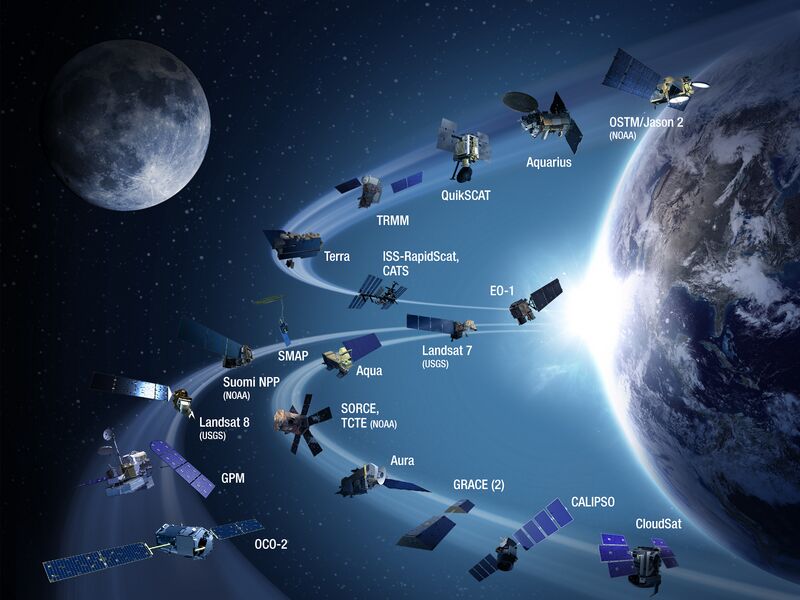File:NASA orbiting fleet 2015.jpg

Original file (1,500 × 1,125 pixels, file size: 866 KB, MIME type: image/jpeg)
The Earth Observation Fleet as of 2016
Earth Science Research from Space
Historic Orbiting Carbon Observatory / OCO-2
○
2015 - Earth Right Now - http://www.jpl.nasa.gov/news/news.php?feature=4487
Over the past 12 months NASA has added five missions to its orbiting Earth-observing, 'remote sensing' capabilities fleet - the biggest one-year increase in more than a decade....
These historic, and uniquely capable space-based missions studying Earth systems provide observations and data aimed at research for environmental security, sustainability, and effective response to changes on Earth.
The scope of Earth science research from space includes atmospheric science; climate change; oceans; biospheres; freshwater systems; aquifers and aquifer depletion; soil and topsoil depletion; forests, loss of CO2 photosynthesis/carbon uptake, and destruction of habitats and biodiversity.
The sets of Earth systems now beginning to be studied, with baseline, specific and longitudinal data accumulated for future studies, is growing into what we (GreenPolicy360 and Strategic Demands) consider "New Definitions of Security."
National and global security are integrally connected to environmental security. In a larger sense "security is indivisible"...
○ ○ ○ ○ ○ ○ ○ ○ ○ ○ ○ ○
A Note from NASA
As of July 2013 - NASA Earth Observation fleet / http://earthobservatory.nasa.gov/IOTD/view.php?id=81559
When most people think about NASA, Earth is not the first thing that comes to mind. Ours agency conjures up thoughts of leaving Earth behind, so it is usually Apollo astronauts, the Moon, Mars, and Hubble views of stars and galaxies that people associate most strongly with NASA’s brand.
However, many astronauts have found the view back at Earth is as compelling as anything else they’ve seen. William Anders, the Apollo 8 astronaut who took the influential Earthrise photograph on Christmas Eve 1968, put it well:
“We came all this way to explore the Moon, and the most important thing is that we discovered the Earth.”
Nearly a half-century later, studying Earth from space is a critical part of NASA’s mission. There are currently sixteen Earth-observing satellites operating in orbit around our planet. The oldest, the Tropical Rainfall Measuring Mission (TRMM) was launched in 1997; the youngest, Landsat 8, was launched in February 2013. Together the fleet monitors a wide range of environmental phenomenon relevant to climate change, weather prediction, fire monitoring, and the health of vegetation.
NASA administrator Charles Bolden highlighted NASA’s Earth-observing satellites in a blog post published in June 2013. He looked ahead at how the fleet will look in the future. “Having looked back at Earth from outer space, I have seen just how fragile our home planet is—and I’m committed to doing everything I can to help protect it...Earth Science is a strong priority of the President’s fiscal year 2014 budget request for NASA. The budget supports seven new Earth Science missions on course to launch through 2020 after the launch of four new Earth science missions in 2014—the Global Precipitation Mission (GPM), Orbiting Carbon Observatory-2 (OCO-2), Soil Moisture Active Passive (SMAP), and the Stratospheric Aerosol and Gas Experiment III (SAGE III) instrument to be launched to the International Space Station.
These cover a wide spectrum of Earth observations and join NASA’s seventeen* Earth science missions in space observing our planet’s atmosphere and oceans, its climate, weather patterns, and much more. The data we collect helps us understand our planet as a dynamic, unified system.”
You can read more about NASA Earth-observing missions by visiting the website of NASA’s Earth Observing System or through the mission list on NASA.gov.
🌎
File history
Click on a date/time to view the file as it appeared at that time.
| Date/Time | Thumbnail | Dimensions | User | Comment | |
|---|---|---|---|---|---|
| current | 12:23, 9 May 2015 |  | 1,500 × 1,125 (866 KB) | Siterunner (talk | contribs) | We gained all this by shooting for the moon -- http://science.nasa.gov/science-news/science-at-nasa/2009/17jul_discoveringearth/ |
You cannot overwrite this file.
File usage
The following page uses this file: